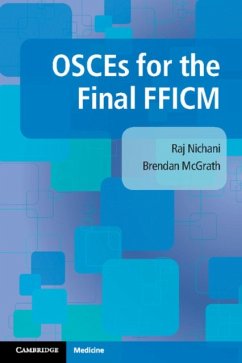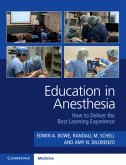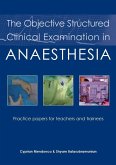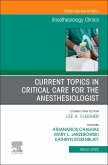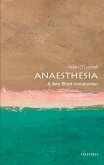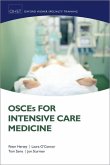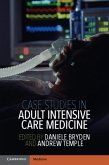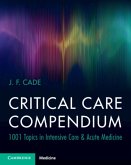- Broschiertes Buch
- Merkliste
- Auf die Merkliste
- Bewerten Bewerten
- Teilen
- Produkt teilen
- Produkterinnerung
- Produkterinnerung
This is an essential text for intensive care medicine trainees preparing to sit the FFICM OSCE examination. With extensive coverage of the syllabus and past exam material, it offers readers an outline of all the important knowledge they will need and allows them to focus their revision on key areas.
Andere Kunden interessierten sich auch für
![Education in Anesthesia Education in Anesthesia]() Education in Anesthesia81,99 €
Education in Anesthesia81,99 €![The Objective Structured Clinical Examination in Anaesthesia: Practice Papers for Teachers and Trainees The Objective Structured Clinical Examination in Anaesthesia: Practice Papers for Teachers and Trainees]() Dr Cyprian MendoncaThe Objective Structured Clinical Examination in Anaesthesia: Practice Papers for Teachers and Trainees46,99 €
Dr Cyprian MendoncaThe Objective Structured Clinical Examination in Anaesthesia: Practice Papers for Teachers and Trainees46,99 €![Current Topics in Critical Care for the Anesthesiologist, an Issue of Anesthesiology Clinics Current Topics in Critical Care for the Anesthesiologist, an Issue of Anesthesiology Clinics]() Current Topics in Critical Care for the Anesthesiologist, an Issue of Anesthesiology Clinics136,99 €
Current Topics in Critical Care for the Anesthesiologist, an Issue of Anesthesiology Clinics136,99 €![Anesthesia Anesthesia]() Aidan O'Donnell (Consultant Anaesthetist, Waikato Hospital, HamiltoAnesthesia17,99 €
Aidan O'Donnell (Consultant Anaesthetist, Waikato Hospital, HamiltoAnesthesia17,99 €![Osces Intens Care Medicine Oxsthr Osces Intens Care Medicine Oxsthr]() Peter Hersey (Consultant, Consultant, Integrated Critical Care UnitOsces Intens Care Medicine Oxsthr77,99 €
Peter Hersey (Consultant, Consultant, Integrated Critical Care UnitOsces Intens Care Medicine Oxsthr77,99 €![Case Studies in Adult Intensive Care Medicine Case Studies in Adult Intensive Care Medicine]() Case Studies in Adult Intensive Care Medicine83,99 €
Case Studies in Adult Intensive Care Medicine83,99 €![Critical Care Compendium Critical Care Compendium]() J. F. Cade (University of Melbourne)Critical Care Compendium84,99 €
J. F. Cade (University of Melbourne)Critical Care Compendium84,99 €-
-
-
This is an essential text for intensive care medicine trainees preparing to sit the FFICM OSCE examination. With extensive coverage of the syllabus and past exam material, it offers readers an outline of all the important knowledge they will need and allows them to focus their revision on key areas.
Hinweis: Dieser Artikel kann nur an eine deutsche Lieferadresse ausgeliefert werden.
Hinweis: Dieser Artikel kann nur an eine deutsche Lieferadresse ausgeliefert werden.
Produktdetails
- Produktdetails
- Verlag: Cambridge University Press
- Seitenzahl: 310
- Erscheinungstermin: 28. Juli 2016
- Englisch
- Abmessung: 233mm x 157mm x 17mm
- Gewicht: 558g
- ISBN-13: 9781107579453
- ISBN-10: 1107579457
- Artikelnr.: 44917911
- Herstellerkennzeichnung
- Libri GmbH
- Europaallee 1
- 36244 Bad Hersfeld
- gpsr@libri.de
- Verlag: Cambridge University Press
- Seitenzahl: 310
- Erscheinungstermin: 28. Juli 2016
- Englisch
- Abmessung: 233mm x 157mm x 17mm
- Gewicht: 558g
- ISBN-13: 9781107579453
- ISBN-10: 1107579457
- Artikelnr.: 44917911
- Herstellerkennzeichnung
- Libri GmbH
- Europaallee 1
- 36244 Bad Hersfeld
- gpsr@libri.de
Raj Nichani is a Consultant in Critical Care and Anaesthesia at the Blackpool Teaching Hospitals NHS Foundation Trust.
Part I. Data Interpretation: 1. Acid base
2. Methaemoglobin
3. Infective diarrhoea and toxic megacolon
4. Major burn
5. Ruptured hemidiaphragm
6. Post cardiac arrest
7. Necrotising fasciitis
8. ARDS
9. Stridor
10. Hyponatraemia
11. Chest drain in liver
12. Interpretation of pulmonary function tests
13. Serotonin syndrome
14. Propofol infusion syndrome
15. Guillain-Barré syndrome
16. Epidural management
17. Panton-Valentine leukocidin (PVL) MRSA pneumonia
18. Surviving (urological) sepsis
19. Ventilator associated pneumonia
20. Refeeding syndrome
21. Acute coronary syndrome and papillary muscle rupture
22. TTP/HUS
23. Subarachnoid haemorrhage
24. Post oesophagectomy anastomotic leak
25. Pulmonary embolism
26. Heparin-induced thrombocytopenia
27. Brainstem death
28. Tricyclic overdose
29. Chest pain assessment
30. Intra abdominal hypertension
31. Selective decontamination of the digestive tract
32. Bone marrow transplant
33. Acute kidney injury
34. Broncho-pleural fistula
35. Myasthenia gravis
36. RV infarct
37. Rhabdomyolysis
38. Cerebrovascular accident
39. Acute leukaemia
40. Diabetic keto acidosis
41. Failure to wean
42. Pleural effusion
43. ICU follow up clinic anaemia
44. Acute liver failure
45. Cirrhosis with upper GI bleeding
46. Sedation and sedation scoring
47. Encephalitis, epilepsy and MRI scans
48. Acute renal failure in a HIV positive man
49. Digoxin toxicity and cardiac pacing
50. Acute pancreatitis
51. Cortisol and thyroxine in the critically ill
52. TEG and major haemorrhage
53. Poisoning
54. ECG interpretation
55. CXR interpretation
Part II. Equipment: 1. Arterial lines
2. Tracheostomy weaning and communication
3. Bronchoscopy
4. Cooling devices
5. PA catheter
6. Naso gastric tubes
7. High flow nasal cannula
8. Cardiac output technologies
9. Catheter related blood stream infection and vancomycin-resistant enterococcus
10. Spinal needles
11. Capnography
12. Patient transfer
13. Tracheostomies
14. Central lines
15. Haemofiltration
16. Intra aortic balloon pump
Part III. Ethics and Communication: 1. Anaphylaxis
2. Pulmonary embolism
3. Malignant hyperpyrexia
4. Organ donation
5. End of life care
6. Muscular dystrophy
7. Delirium
8. Deterioration post discharge
9. Consent for tracheostomy
10. Blood transfusion
11. Alcoholic liver disease
12. Long QT
Part IV. Resuscitation: Introduction
1. Displaced airway
2. Child submersion
3. Child with seizures
4. Bleeding trauma with head injury
5. Asthma
6. Pregnancy and VF arrest
7. Chest opening on the ICU
8. Paediatric sepsis
9. Tracheostomy emergency
10. Anaphylaxis.
2. Methaemoglobin
3. Infective diarrhoea and toxic megacolon
4. Major burn
5. Ruptured hemidiaphragm
6. Post cardiac arrest
7. Necrotising fasciitis
8. ARDS
9. Stridor
10. Hyponatraemia
11. Chest drain in liver
12. Interpretation of pulmonary function tests
13. Serotonin syndrome
14. Propofol infusion syndrome
15. Guillain-Barré syndrome
16. Epidural management
17. Panton-Valentine leukocidin (PVL) MRSA pneumonia
18. Surviving (urological) sepsis
19. Ventilator associated pneumonia
20. Refeeding syndrome
21. Acute coronary syndrome and papillary muscle rupture
22. TTP/HUS
23. Subarachnoid haemorrhage
24. Post oesophagectomy anastomotic leak
25. Pulmonary embolism
26. Heparin-induced thrombocytopenia
27. Brainstem death
28. Tricyclic overdose
29. Chest pain assessment
30. Intra abdominal hypertension
31. Selective decontamination of the digestive tract
32. Bone marrow transplant
33. Acute kidney injury
34. Broncho-pleural fistula
35. Myasthenia gravis
36. RV infarct
37. Rhabdomyolysis
38. Cerebrovascular accident
39. Acute leukaemia
40. Diabetic keto acidosis
41. Failure to wean
42. Pleural effusion
43. ICU follow up clinic anaemia
44. Acute liver failure
45. Cirrhosis with upper GI bleeding
46. Sedation and sedation scoring
47. Encephalitis, epilepsy and MRI scans
48. Acute renal failure in a HIV positive man
49. Digoxin toxicity and cardiac pacing
50. Acute pancreatitis
51. Cortisol and thyroxine in the critically ill
52. TEG and major haemorrhage
53. Poisoning
54. ECG interpretation
55. CXR interpretation
Part II. Equipment: 1. Arterial lines
2. Tracheostomy weaning and communication
3. Bronchoscopy
4. Cooling devices
5. PA catheter
6. Naso gastric tubes
7. High flow nasal cannula
8. Cardiac output technologies
9. Catheter related blood stream infection and vancomycin-resistant enterococcus
10. Spinal needles
11. Capnography
12. Patient transfer
13. Tracheostomies
14. Central lines
15. Haemofiltration
16. Intra aortic balloon pump
Part III. Ethics and Communication: 1. Anaphylaxis
2. Pulmonary embolism
3. Malignant hyperpyrexia
4. Organ donation
5. End of life care
6. Muscular dystrophy
7. Delirium
8. Deterioration post discharge
9. Consent for tracheostomy
10. Blood transfusion
11. Alcoholic liver disease
12. Long QT
Part IV. Resuscitation: Introduction
1. Displaced airway
2. Child submersion
3. Child with seizures
4. Bleeding trauma with head injury
5. Asthma
6. Pregnancy and VF arrest
7. Chest opening on the ICU
8. Paediatric sepsis
9. Tracheostomy emergency
10. Anaphylaxis.
Part I. Data Interpretation: 1. Acid base
2. Methaemoglobin
3. Infective diarrhoea and toxic megacolon
4. Major burn
5. Ruptured hemidiaphragm
6. Post cardiac arrest
7. Necrotising fasciitis
8. ARDS
9. Stridor
10. Hyponatraemia
11. Chest drain in liver
12. Interpretation of pulmonary function tests
13. Serotonin syndrome
14. Propofol infusion syndrome
15. Guillain-Barré syndrome
16. Epidural management
17. Panton-Valentine leukocidin (PVL) MRSA pneumonia
18. Surviving (urological) sepsis
19. Ventilator associated pneumonia
20. Refeeding syndrome
21. Acute coronary syndrome and papillary muscle rupture
22. TTP/HUS
23. Subarachnoid haemorrhage
24. Post oesophagectomy anastomotic leak
25. Pulmonary embolism
26. Heparin-induced thrombocytopenia
27. Brainstem death
28. Tricyclic overdose
29. Chest pain assessment
30. Intra abdominal hypertension
31. Selective decontamination of the digestive tract
32. Bone marrow transplant
33. Acute kidney injury
34. Broncho-pleural fistula
35. Myasthenia gravis
36. RV infarct
37. Rhabdomyolysis
38. Cerebrovascular accident
39. Acute leukaemia
40. Diabetic keto acidosis
41. Failure to wean
42. Pleural effusion
43. ICU follow up clinic anaemia
44. Acute liver failure
45. Cirrhosis with upper GI bleeding
46. Sedation and sedation scoring
47. Encephalitis, epilepsy and MRI scans
48. Acute renal failure in a HIV positive man
49. Digoxin toxicity and cardiac pacing
50. Acute pancreatitis
51. Cortisol and thyroxine in the critically ill
52. TEG and major haemorrhage
53. Poisoning
54. ECG interpretation
55. CXR interpretation
Part II. Equipment: 1. Arterial lines
2. Tracheostomy weaning and communication
3. Bronchoscopy
4. Cooling devices
5. PA catheter
6. Naso gastric tubes
7. High flow nasal cannula
8. Cardiac output technologies
9. Catheter related blood stream infection and vancomycin-resistant enterococcus
10. Spinal needles
11. Capnography
12. Patient transfer
13. Tracheostomies
14. Central lines
15. Haemofiltration
16. Intra aortic balloon pump
Part III. Ethics and Communication: 1. Anaphylaxis
2. Pulmonary embolism
3. Malignant hyperpyrexia
4. Organ donation
5. End of life care
6. Muscular dystrophy
7. Delirium
8. Deterioration post discharge
9. Consent for tracheostomy
10. Blood transfusion
11. Alcoholic liver disease
12. Long QT
Part IV. Resuscitation: Introduction
1. Displaced airway
2. Child submersion
3. Child with seizures
4. Bleeding trauma with head injury
5. Asthma
6. Pregnancy and VF arrest
7. Chest opening on the ICU
8. Paediatric sepsis
9. Tracheostomy emergency
10. Anaphylaxis.
2. Methaemoglobin
3. Infective diarrhoea and toxic megacolon
4. Major burn
5. Ruptured hemidiaphragm
6. Post cardiac arrest
7. Necrotising fasciitis
8. ARDS
9. Stridor
10. Hyponatraemia
11. Chest drain in liver
12. Interpretation of pulmonary function tests
13. Serotonin syndrome
14. Propofol infusion syndrome
15. Guillain-Barré syndrome
16. Epidural management
17. Panton-Valentine leukocidin (PVL) MRSA pneumonia
18. Surviving (urological) sepsis
19. Ventilator associated pneumonia
20. Refeeding syndrome
21. Acute coronary syndrome and papillary muscle rupture
22. TTP/HUS
23. Subarachnoid haemorrhage
24. Post oesophagectomy anastomotic leak
25. Pulmonary embolism
26. Heparin-induced thrombocytopenia
27. Brainstem death
28. Tricyclic overdose
29. Chest pain assessment
30. Intra abdominal hypertension
31. Selective decontamination of the digestive tract
32. Bone marrow transplant
33. Acute kidney injury
34. Broncho-pleural fistula
35. Myasthenia gravis
36. RV infarct
37. Rhabdomyolysis
38. Cerebrovascular accident
39. Acute leukaemia
40. Diabetic keto acidosis
41. Failure to wean
42. Pleural effusion
43. ICU follow up clinic anaemia
44. Acute liver failure
45. Cirrhosis with upper GI bleeding
46. Sedation and sedation scoring
47. Encephalitis, epilepsy and MRI scans
48. Acute renal failure in a HIV positive man
49. Digoxin toxicity and cardiac pacing
50. Acute pancreatitis
51. Cortisol and thyroxine in the critically ill
52. TEG and major haemorrhage
53. Poisoning
54. ECG interpretation
55. CXR interpretation
Part II. Equipment: 1. Arterial lines
2. Tracheostomy weaning and communication
3. Bronchoscopy
4. Cooling devices
5. PA catheter
6. Naso gastric tubes
7. High flow nasal cannula
8. Cardiac output technologies
9. Catheter related blood stream infection and vancomycin-resistant enterococcus
10. Spinal needles
11. Capnography
12. Patient transfer
13. Tracheostomies
14. Central lines
15. Haemofiltration
16. Intra aortic balloon pump
Part III. Ethics and Communication: 1. Anaphylaxis
2. Pulmonary embolism
3. Malignant hyperpyrexia
4. Organ donation
5. End of life care
6. Muscular dystrophy
7. Delirium
8. Deterioration post discharge
9. Consent for tracheostomy
10. Blood transfusion
11. Alcoholic liver disease
12. Long QT
Part IV. Resuscitation: Introduction
1. Displaced airway
2. Child submersion
3. Child with seizures
4. Bleeding trauma with head injury
5. Asthma
6. Pregnancy and VF arrest
7. Chest opening on the ICU
8. Paediatric sepsis
9. Tracheostomy emergency
10. Anaphylaxis.

